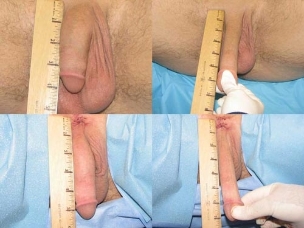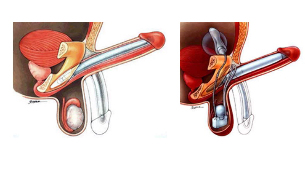There are several types of penis enlargement surgeries, some of which are capable of increasing the penis in length, others in width. These operations are performed separately, even if you want to increase both indicators. Before deciding on a surgical intervention, all the pros and cons should be weighed.
Types of penis enlargement surgeries
There are several types of penis enlargement surgeries. The method of the procedure depends on the type of correction the patient needs. Ligamentotomy is used to lengthen the penis. This procedure makes it possible to "stretch" the organ by a few centimeters. Indicated only in cases where the original length of the penis does not deviate much from the norm. In addition, it is contraindicated for erection problems. It should be noted that the thickness of the organ does not change as a result of such interventions. Other methods are used to thicken the organ: fat filling and implantation of muscle tissue.
Penis surgery requires a high level of skill and effort on the part of doctors and is always associated with certain health risks. An example is the procedure known as "Perovik". Such an operation involves the separation of the cavernous bodies and the head of the penis. Cartilage tissue is implanted in the space that appears, due to which it is possible to achieve an organ growth. You can also get good results with the help of penile prosthetics. This surgery is recommended for patients with impaired erectile function.
Certain indications are required for penile surgery. The operation is performed by a surgeon-urologist / andrologist.
How much can the member be maximized using the operation

With the help of surgery, you can maximize the penis in length by 3-5 centimeters, in width by 3-4 cm. But in each case, the results may be different, it all depends on several points: the type of surgery, the anatomical and physiological characteristics of the patient. . .
Who needs penis enlargement surgery
Penis size depends on genetic factors and individual developmental characteristics. The formation of a male member may be concerned if, during the process of growth and puberty, the boy's body has experienced a lack of testosterone. Once puberty is over, using testosterone to stimulate penis growth usually makes no sense. The genital organ can be very small in congenital conditions such as epispadias, hypospadias, as well as after traumatic injuries and surgical interventions.
Before deciding on surgery, a man with a small penis is advised by a medical specialist. Doctors working in this field argue that in most cases the problem of a "small" penis is more psychological. Doubts about their sexual power lower a man’s self-esteem, trigger complexes and feelings of self-confidence. A depressed morality negatively affects all areas of a man’s life.
And yet, the operation is not performed for everyone. The main indicator is micropenis. This pathology is usually caused by a violation of the hormonal function of the pituitary gland and, fortunately, is not common. Importers It is important to remember that body parameters should only be measured in an elevated position, in a standing position. Length is measured from the base to the end of the head.
If along with insufficient size there are penile malfunctions, then surgery may simply become necessary.
Penis abnormalities and acquired deformities include hypospadias, espospadias, cavernous fibrosis, and penile trauma.
In older men, organ involvement is possible. It is based on factors such as overweight, decreased muscle tone and decreased tissue elasticity. These age-related changes are not a mandatory indicator for surgery. Surgical procedures are performed only at the request of the patient.
Indications for penis enlargement
- The length of the penis is less than 8-10 cm in an erect position.
- Penile injuries that result in complications.
- Congenital pathologies (epispadias and hypospadias).
- Cavernous fibrosis.
- Age-related changes.
- Membrane or hidden member.
- Dysmorphophobia of the penis (psychological problems associated with penis size).
Sometimes the operation is performed even if the indicated indications are missing. For example, with erectile dysfunction that can not be cured with drug therapy, or simply at the request of the patient. But the doctor makes the decision for surgery individually for each patient. It all depends on the general state of his health and the characteristics of the organism.
Contraindications to penile enlargement
There are contraindications that force you to use non-surgical methods of penis enlargement:
- diabetes mellitus;
- genital herpes;
- infectious and inflammatory diseases of the genitourinary system;
- acute urethritis;
- cystitis;
- acute and chronic prostatitis;
- inguinal hernia;
- various dermatitis;
- prostate cancer and other malignant tumors;
- prostate adenoma;
- paralysis.
All methods and methods of penis enlargement without surgery are described in detail on our website.
Ligamentotomy - penis enlargement surgery
Surgery to increase the length of the penis is called ligamentotomy. This operation is not complex. Not everyone knows that the penis is actually somewhat longer than we can see. Its hidden part is located under the pubic bone. In this position, the organ is supported by a special ligament. It has such a structure that it stays in this state when stretched for a long time. Likewise with shrinkage. The purpose of the operation is to weaken the ligament and release the hidden part of the organ. To do this, an incision is made in the ligament, it is stretched and the penis is extended by 3-5 cm. After surgery, it is necessary to wear an extension to stretch the ligament.
There are several other options for this intervention, depending on the type of access using dentures.
Types of ligamentotomy surgery
- Cross sections of tunica albuginea with prosthesis implantation. In this type of surgery, the prosthesis is placed in the intracavernous space and cross-sections are made to lengthen the penis.
- Implantation with mobilization of the penis legs. The intervention involves the maximum removal of the central part of the cavernous corpus, their movement and fixation in the pubic articulation.
- Merge operation. In this case, the organ is divided into its constituent elements. The corpus cavernosum is separated from the corpus spongiosum and the head of the penis. A complete mobilization of blood vessels and nerves is also required. A prosthesis or artificial cartilage is placed between the edges of the cavernous bodies and the head
Penis enlarges due to spongy body extension, nerves, blood vessels. The doctor dissects the ligament to release the penis. The hidden area is extended using an extender. The rehabilitation period after such a procedure lasts at least 5 weeks.
Implantation is usually performed for those patients who have undergone surgery on the bladder, prostate, rectum. There are different types of prostheses. Usually, preference is given to inflatable, variable stiffness. In the absence of erectile dysfunction, such interventions are not indicated.
Preparing for the operation
Prior to the surgical procedure, the patient should undergo a general clinical diagnosis. Also, you need to understand its maximum elevation. With the help of ultrasound, it is determined if there are any defects in the tunica albuginea, cavernous bodies and blood supply. Local anesthesia is often used. The hospital stay is about one day.
Ligamentotomy: before and after photos

Thickening operations for members
Some men want to increase not the length of the penis, but its thickness. They believe this will help them improve their quality of sex life. There are two main methods for achieving penile thickening - lipofilling and muscle tissue transplantation.
Liposuction
Lipofilling involves the introduction of fat into the subcutaneous tissue of an organ. Adipose tissue for the procedure is taken from other parts of the patient's body (buttocks or abdomen) and subjected to special cleansing. The fat is then injected into the tissue of the penis using a needle. As a result, the diameter of the organ becomes approximately 1 cm larger. The operation does not pose a health risk and does not require lengthy rehabilitation. But the result, unfortunately, is not permanent. Therefore, the intervention should be repeated periodically.
Penile Muscle Transplant
Muscle transplantation is a more complex manipulation. Transplant material is obtained from the abdominal wall or axillary fascia. The penis is "wrapped" with muscle tissue, which gives a significant increase in thickness - up to 3-4 cm.
Penile Prosthetics
The traditional way to enlarge the penis with surgery is prosthesis. Such an intervention is performed only if there are certain indications. These include not only insufficient size, but also a violation of sexual function.

Cartilage tissue or artificial materials are used for falloprosthesis. Such procedures are complex manipulations and are not recommended for patients with serious somatic diseases.
The optimal order is a prosthesis equipped with an inflatable mechanism. Allows you to have a normal sex life with the ability to independently adjust the collection rate. Unfortunately, not everyone can afford such implants. Therefore, the patient can choose a more affordable alternative. All modern implants are made exclusively from elastic materials.
Answer for penis enlargement surgery
Reviews of men who have had their penis enlarged with surgery are different. Many were pleased with the result, especially when the prostheses with expensive high-quality implants. Ligamentotomy also gained a positive rating in men, most patients noted a sufficient growth in the penis. As for lipofillig, there are also cases of dissatisfaction. Some men complain about the short duration of the result and the uneven distribution of adipose tissue along the penis.
Is it possible to thicken and lengthen the penis at the same time?
In theory, such a procedure is feasible, but it is highly undesirable to do so. First, the penis should be extended to the desired result, then think about its thickening. The fact is that the volume of tissue used to thicken the organ is calculated according to the size of the hanging part of the penis. Therefore, performing two procedures at the same time can lead to a noticeable deformation of the penis and other unpleasant consequences.
Possible complications after penile surgery
Typical early complications include:
- swelling of the penis
- Bleeding.
- Wound infection.
- Decreased (sometimes permanent) scalp sensitivity.
- Painful sensations during erection.
These complications can develop during the first weeks after surgery.
The most likely late complications are:
- Penis shortening.
- Penile instability during sexual intercourse.
- Erectile dysfunction.
- Insensitivity of the head.
- Organ deformities.
- Angle of change of erection, when the penis is not directed upwards, but downwards or forward (after tearing of the supporting ligaments).
- Resorption or necrosis of implanted tissue in the penis.
Important to know!In more than half of the cases, the result of the operation does not meet the husband's expectations.
Where is the best place to enlarge your penis?
First of all, you must understand that it is impossible to get the desired result without the participation of a qualified medical specialist. Popularly advertised popular methods, healing services and dubious herbal preparations will deeply disappoint you.
If you want real results with minimal risk of side effects, seek medical attention. The urologist-andrologist will listen to the complaints, perform an initial examination and discuss with you all the options that are appropriate for your case. You will be able to get detailed advice on different methods of penis enlargement, learn about the possible risks and side effects.
If you decide to have an operation, you should get information about the technique of the method, the features of the procedure, the duration of the hospital treatment. The surgeon should also tell you how long the rehabilitation period will last, when you can resume sexual activity, and how to reduce the likelihood of complications.
Alert should be triggered by specialists who describe only the advantages of the recommended procedure and remain completely silent about the possible disadvantages and risks.
Never make a choice too quickly if you think the doctor is pushing for his services. Do not give in to pressure, think carefully about all the nuances in a calm atmosphere in order to make the right decision. If the doctor does not enjoy a reputation as a qualified specialist among colleagues and patients, it is better to refuse his help.
Before starting treatment, you may be required to sign an informed contract and consent. Do not rush to place your signature, first read the document carefully, thinking about each of its points.
Important!The contract necessarily defines all the points related to the treatment and further relations with the medical center. Remember that penis enlargement is a demanding task that requires good preparation, deep knowledge and strict adherence to all the rules for performing the operation.
Summary
Specialists of the Surgical Academy presented a report, which points out the lack of effectiveness of existing techniques and the possibility of serious consequences. Thus, the widely used procedure for ligament rupture can provoke erectile dysfunction. Adipose tissue transplantation gives only a short-term cosmetic result. As for silicon and other synthetic fillers, French scientists propose to abandon them altogether.
The methods described above can only be used in cases where it is necessary to eliminate a congenital anomaly as a result of an injury or a malignant process. That is, the list of indications is strictly limited.
If a man with a normal penis size turns to him for help, it is the doctor's job to explain to the person in plain language that his demands are unreasonable and that he does not need surgery. It is also necessary to describe in detail all possible side effects and health risks after surgery.

























